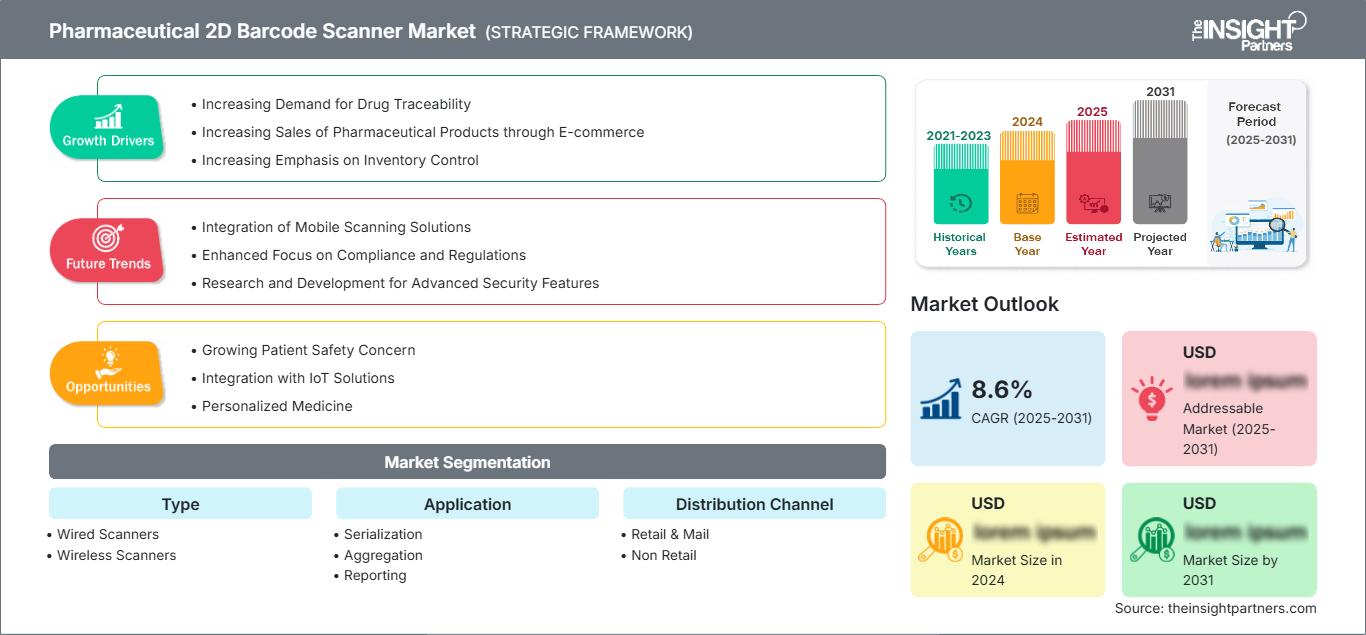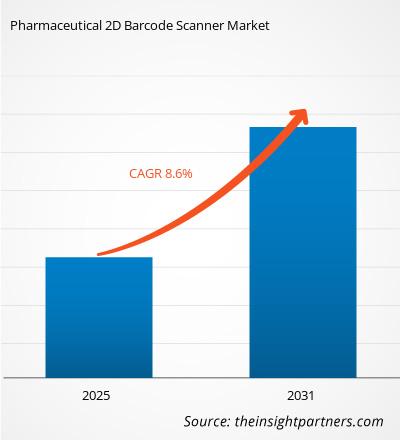Se espera que el mercado de escáneres de códigos de barras 2D farmacéuticos alcance los 18.770 millones de dólares estadounidenses para 2031. Se prevé que registre una tasa de crecimiento anual compuesta (TCAC) del 9,3 % entre 2025 y 2031.
El informe está segmentado por tipo (escáneres con cable, escáneres inalámbricos). Además, presenta un análisis por aplicación (serialización, agregación, informes, otras aplicaciones). Asimismo, se segmenta por canal de distribución (minorista y correo, no minorista). El análisis global se desglosa por región y por país principal. El informe ofrece el valor en USD para el análisis y los segmentos mencionados.
Propósito del Informe
El informe "Mercado de escáneres de códigos de barras 2D farmacéuticos", elaborado por The Insight Partners, busca describir el panorama actual y el crecimiento futuro, los principales factores impulsores, los desafíos y las oportunidades. Esto proporcionará información a diversas partes interesadas del negocio, como:
- Proveedores/fabricantes de tecnología: Para comprender la dinámica cambiante del mercado y conocer las oportunidades potenciales de crecimiento, lo que les permitirá tomar decisiones estratégicas informadas.
- Inversores: Realizar un análisis exhaustivo de tendencias respecto a la tasa de crecimiento del mercado, las proyecciones financieras del mercado y las oportunidades que existen en toda la cadena de valor.
- Órganos reguladores: Regular las políticas y las actividades policiales en el mercado con el objetivo de minimizar el abuso, preservar la confianza de los inversores y defender la integridad y estabilidad del mercado.
Segmentación del mercado de escáneres de códigos de barras 2D farmacéuticos
- Escáneres con cable
- Escáneres inalámbricos
Solicitud
- Publicación por entregas
- Agregación
- Informes
- Otras aplicaciones
Canal de distribución
- Venta minorista y correo
- No minorista
Geografía
- América del norte
- Europa
- Asia-Pacífico
- América del Sur y Central
- Oriente Medio y África
Obtendrá personalización en cualquier informe, sin cargo, incluidas partes de este informe o análisis a nivel de país, paquete de datos de Excel, así como también grandes ofertas y descuentos para empresas emergentes y universidades.
Mercado de escáneres de códigos de barras 2D farmacéuticos: Perspectivas estratégicas

-
Obtenga las principales tendencias clave del mercado de este informe.Esta muestra GRATUITA incluirá análisis de datos, desde tendencias del mercado hasta estimaciones y pronósticos.
Factores que impulsan el crecimiento del mercado de escáneres de códigos de barras 2D farmacéuticos
- Creciente demanda de trazabilidad de medicamentos: La creciente demanda de trazabilidad de medicamentos es otro factor clave para el crecimiento de los lectores de códigos de barras 2D. El cumplimiento normativo para el seguimiento de medicamentos en la cadena de suministro obliga a los fabricantes farmacéuticos a utilizar tecnología de escaneo mejorada. Esto mejora la seguridad de los productos y garantiza el cumplimiento de los estándares de la industria.
- Aumento de las ventas de productos farmacéuticos a través del comercio electrónico: Los avances en el comercio electrónico están generando un aumento en las ventas de productos farmacéuticos. Con el auge del comercio electrónico, las farmacias online están ganando popularidad, por lo que la gestión óptima del inventario y el procesamiento de pedidos requerirán sistemas eficientes de seguimiento del inventario y escaneo de pedidos. Los lectores de códigos de barras ayudan a optimizar los procesos y a lograr mayor precisión en cada transacción.
- Mayor énfasis en el control de inventario: Las empresas farmacéuticas implementan cada vez más prácticas de control más sólidas para la gestión de inventario, lo que genera una gran demanda de lectores de códigos de barras 2D. Se reducen los errores en la contabilización del inventario de medicamentos y se minimiza el desperdicio. La creciente preocupación de los operadores de servicios de salud por las cadenas de suministro impulsa la adopción de la tecnología de escaneo de códigos de barras para un control eficaz del inventario y la eficiencia operativa.
Tendencias futuras del mercado de escáneres de códigos de barras 2D farmacéuticos
- Integración de soluciones de escaneo móvil: Las soluciones de escaneo móvil son un desarrollo en rápido crecimiento en el mercado farmacéutico de escáneres de códigos de barras 2D. La gestión de inventarios y la verificación de medicamentos mediante aplicaciones de escaneo móvil han incrementado el uso de teléfonos inteligentes y tabletas. Estas adaptaciones hacen que las operaciones sean más accesibles y flexibles, permitiendo a los profesionales de la salud implementar sus tareas sin una inversión excesiva en equipos de escaneo especializados.
- Mayor enfoque en el cumplimiento normativo y las regulaciones: La industria farmacéutica mantiene un estricto cumplimiento normativo, lo que aumenta la demanda de soluciones más nuevas y avanzadas, como el escaneo de códigos de barras. La creciente exigencia de trazabilidad y generación de informes por parte de los principales organismos reguladores obliga a las empresas a invertir en sofisticados escáneres 2D para el escaneo de códigos de barras 2D y así cumplir con las normas mencionadas, o bien, arriesgarse a posibles incumplimientos.
- Investigación y desarrollo de funciones de seguridad avanzadas: Se basa en la creciente preocupación por los medicamentos falsificados, y el escáner de códigos de barras 2D farmacéutico necesita urgentemente funciones de seguridad avanzadas. También se está desarrollando la estandarización de innovaciones como los códigos de barras encriptados y los envases con precinto de seguridad. Las mejoras incluyen la integridad de la cadena de suministro de medicamentos, el aumento de la confianza del consumidor y el impulso a la adopción de tecnologías de escaneo seguro.
Oportunidades de mercado de escáneres de códigos de barras 2D farmacéuticos
- Creciente preocupación por la seguridad del paciente: La creciente preocupación de los pacientes por la seguridad y la precisión de la medicación está impulsando el mercado de los lectores de códigos de barras 2D. El escaneo de medicamentos antes de la administración garantiza una medicación sin errores y la correcta administración de los medicamentos correctos al paciente. Esta concienciación sobre la seguridad está impulsando a las organizaciones sanitarias a invertir en nuevos productos de escaneo de códigos de barras que optimizan los procesos de gestión de medicamentos.
- Integración con soluciones IoT: Cabe mencionar que la integración con soluciones IoT crea nuevas oportunidades para los lectores de códigos de barras 2D. Por lo tanto, con la integración de los lectores con plataformas IoT, el análisis de datos en tiempo real y la gestión del inventario en tiempo real mejorarán la eficiencia operativa y permitirán comprender mejor el proceso de la cadena de suministro, impulsando así la adopción de soluciones de escaneo integradas.
- Medicina personalizada: Esta medicina personalizada abre nuevas vías para los códigos de barras farmacéuticos. A medida que la industria continúa desarrollando más terapias farmacológicas dirigidas, el monitoreo preciso de los medicamentos para cada paciente se vuelve crucial. Ahora, la precisión de los lectores de códigos de barras garantiza el tratamiento correcto que se prescribe al paciente. Los profesionales de la salud pueden gestionar y verificar las recetas de forma eficiente en el contexto de la medicina personalizada. Este factor también ha incrementado la demanda de sistemas de escaneo avanzados.
Perspectivas regionales del mercado de escáneres de códigos de barras 2D farmacéuticos
Los analistas de The Insight Partners han explicado detalladamente las tendencias regionales y los factores que influyen en el mercado de escáneres de códigos de barras 2D farmacéuticos durante el período de pronóstico. Esta sección también analiza los segmentos y la geografía del mercado de escáneres de códigos de barras 2D farmacéuticos en América del Norte, Europa, Asia Pacífico, Oriente Medio y África, y América del Sur y Central.
Alcance del informe de mercado de escáneres de códigos de barras 2D farmacéuticos
| Atributo del informe | Detalles |
|---|---|
| Tamaño del mercado en 2024 | XX mil millones de dólares estadounidenses |
| Tamaño del mercado en 2031 | US$ 18.77 mil millones |
| CAGR global (2025-2031) | 9,3% |
| Datos históricos | 2021-2023 |
| Período de pronóstico | 2025-2031 |
| Segmentos cubiertos |
Por tipo
|
| Regiones y países cubiertos |
América del norte
|
| Líderes del mercado y perfiles de empresas clave |
|
Densidad de actores del mercado de escáneres de códigos de barras 2D farmacéuticos: comprensión de su impacto en la dinámica empresarial
El mercado de escáneres de códigos de barras 2D para la industria farmacéutica está creciendo rápidamente, impulsado por la creciente demanda de los usuarios finales debido a factores como la evolución de las preferencias de los consumidores, los avances tecnológicos y un mayor conocimiento de los beneficios del producto. A medida que aumenta la demanda, las empresas amplían su oferta, innovan para satisfacer las necesidades de los consumidores y aprovechan las tendencias emergentes, lo que impulsa aún más el crecimiento del mercado.

- Obtenga una descripción general de los principales actores clave del mercado de escáneres de códigos de barras 2D farmacéuticos
Puntos clave de venta
- Cobertura integral: el informe cubre de manera integral el análisis de productos, servicios, tipos y usuarios finales del mercado de escáneres de código de barras 2D farmacéuticos, proporcionando un panorama holístico.
- Análisis de expertos: el informe se compila con base en el conocimiento profundo de expertos y analistas de la industria.
- Información actualizada: El informe asegura relevancia comercial debido a su cobertura de información reciente y tendencias de datos.
- Opciones de personalización: este informe se puede personalizar para satisfacer los requisitos específicos del cliente y adaptarse adecuadamente a las estrategias comerciales.
Por lo tanto, el informe de investigación sobre el mercado de escáneres de códigos de barras 2D farmacéuticos puede ayudar a descifrar y comprender el panorama de la industria y sus perspectivas de crecimiento. Si bien existen algunas preocupaciones válidas, las ventajas generales de este informe tienden a superar las desventajas.
- Análisis histórico (2 años), año base, pronóstico (7 años) con CAGR
- Análisis PEST y FODA
- Tamaño del mercado, valor/volumen: global, regional y nacional
- Industria y panorama competitivo
- Conjunto de datos de Excel
Informes recientes
Informes relacionados
Testimonios
Razón para comprar
- Toma de decisiones informada
- Comprensión de la dinámica del mercado
- Análisis competitivo
- Información sobre clientes
- Pronósticos del mercado
- Mitigación de riesgos
- Planificación estratégica
- Justificación de la inversión
- Identificación de mercados emergentes
- Mejora de las estrategias de marketing
- Impulso de la eficiencia operativa
- Alineación con las tendencias regulatorias






















 Obtenga una muestra gratuita para - Mercado de escáneres de códigos de barras 2D para la industria farmacéutica
Obtenga una muestra gratuita para - Mercado de escáneres de códigos de barras 2D para la industria farmacéutica